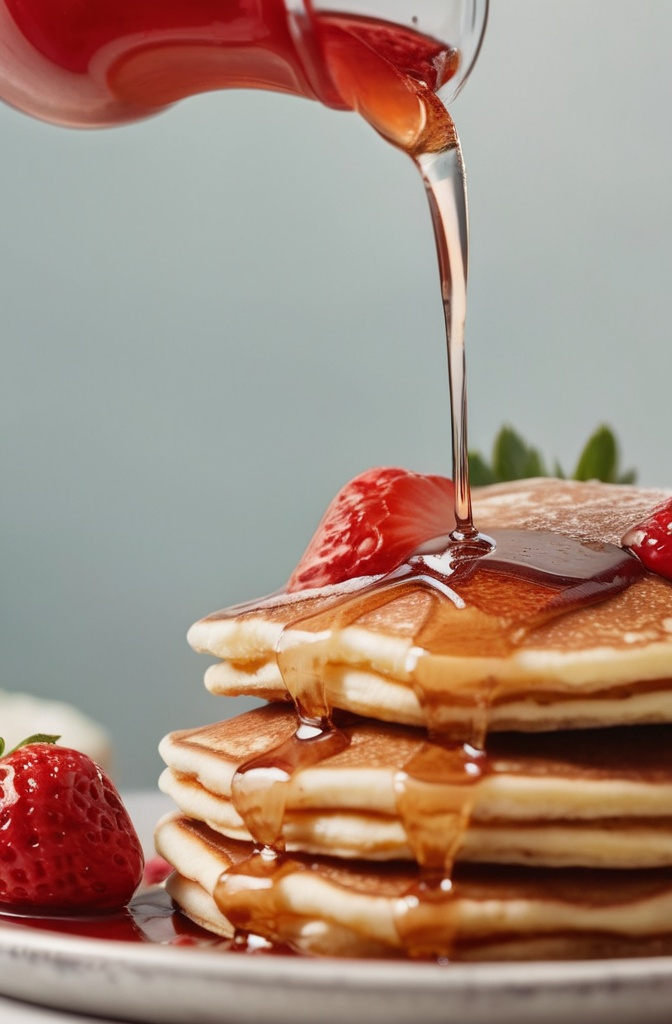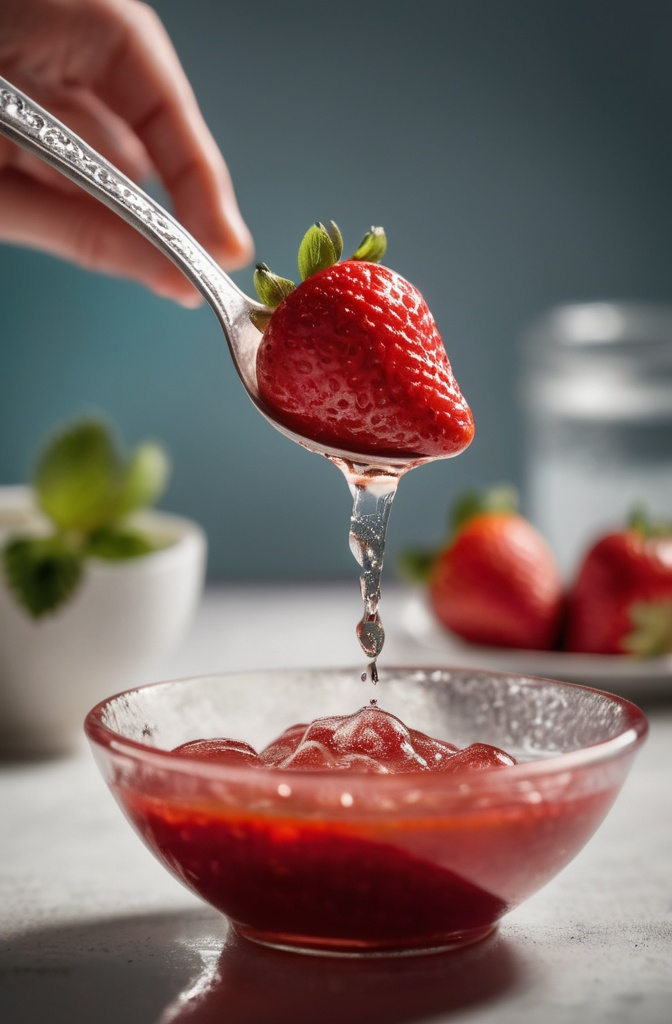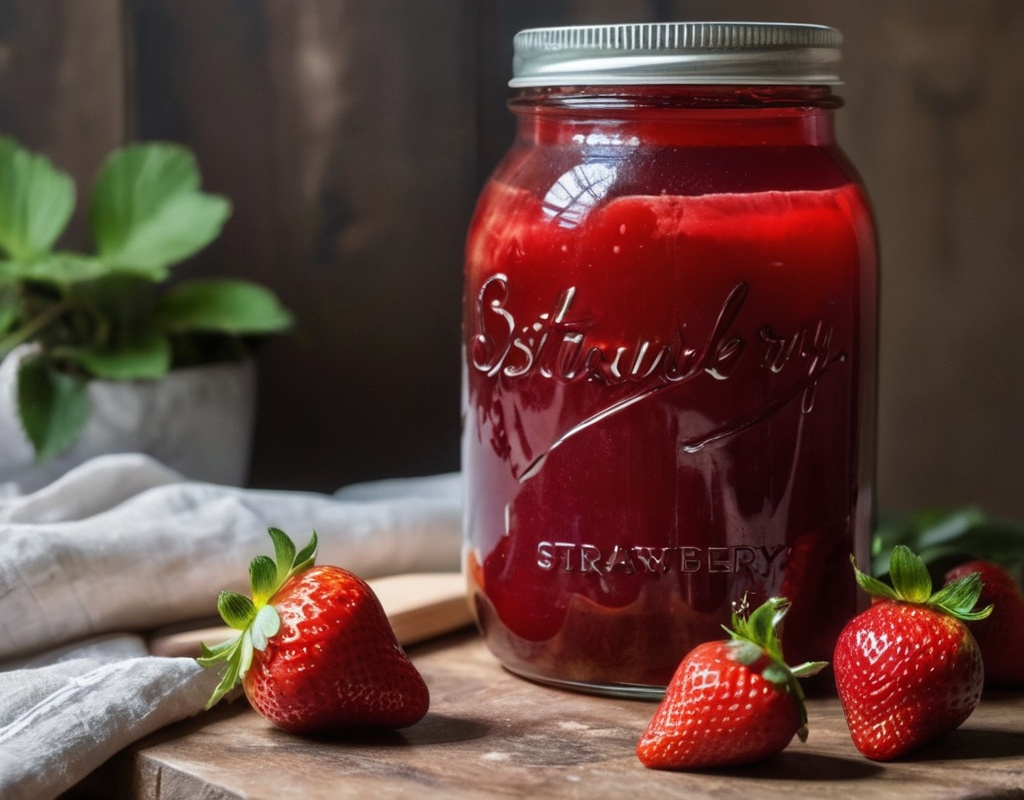Strawberry syrup – it’s the nectar that turns the ordinary into the extraordinary. Whether it’s poured over pancakes, stirred into cocktails, or swirled through a milkshake, this vibrant, sweet concoction adds magic to many dishes. But there’s so much more than meets the eye when it comes to crafting the perfect strawberry syrup. In this article, I’m diving deep into the nuts and bolts of strawberry syrup, from its history and use in professional kitchens, to tips and techniques for getting the perfect consistency and flavor.
When done right, strawberry syrup is a work of art. If you’ve ever tasted a subpar version, you know it’s not just about slapping some sugar on strawberries and calling it a day. No, strawberry syrup requires patience, attention to detail, and a bit of culinary know-how to master. So let’s talk all things syrupy.
What is Strawberry Syrup?
At its core, strawberry syrup is a mixture of strawberries, sugar, and often a little water. Simple, right? But achieving the perfect balance is key. You want that sweet, fresh strawberry flavor to shine without overwhelming your dish or drink. It’s a concentrated liquid, usually with a smooth or slightly chunky texture, used to enhance desserts, beverages, and even savory dishes.
But what makes strawberry syrup stand out among all the fruit syrups out there? It’s the ability to perfectly capture the essence of strawberries. The bright, tangy flavor of fresh strawberries combined with just the right amount of sweetness creates a product that’s versatile and can enhance a range of dishes.
History of Strawberry Syrup
Strawberry syrup didn’t just appear overnight. The use of fruits in syrups can be traced back centuries. Before refrigeration and modern preservation methods, fruits like strawberries were often preserved in syrup to extend their shelf life. Strawberry syrup as we know it today began to gain popularity in the early 20th century, especially with the rise of soda fountains and milkshakes in the United States.
It wasn’t just a novelty for drinks, either. The use of strawberry syrup spread quickly to many culinary applications. It became a key ingredient in the kitchens of professional chefs and home cooks alike. Today, it’s not just an ingredient; it’s a staple that elevates everyday meals and creates an indulgent moment when used in the right context.
The Art of Making Strawberry Syrup
Sure, you could just boil some strawberries and sugar together, but the magic happens when you go beyond the basic. Making strawberry syrup involves more than just throwing ingredients into a pot. You’ve gotta pay attention to the little details. Let’s break it down.

Choosing the Right Strawberries
First thing’s first – pick good strawberries. The flavor of your syrup will only be as good as the strawberries you start with. Look for ripe, fresh strawberries. Not the ones that look like they’ve been sitting around for days. The best strawberries will give you a naturally sweet, vibrant flavor without the need for a ton of added sugar. If you can’t get fresh ones, frozen strawberries can work, but fresh is always better for that pure strawberry taste.
The Right Sugar-to-Strawberry Ratio
The key to great strawberry syrup is finding the right balance between sugar and fruit. Too much sugar, and you risk it tasting more like candy than fruit. Too little, and it might end up too tart or thin. The ideal ratio is typically 1:1 – one part sugar to one part strawberries – but this can vary depending on the sweetness of the fruit you’re using and your personal taste.
A lot of professional chefs will experiment with ratios. Some use a little less sugar and add lemon juice or a pinch of salt to balance the sweetness, bringing out the natural tanginess of the strawberries. Others may prefer a thicker syrup with a higher sugar concentration. This is where personal preference really starts to shine through in the syrup-making process.
The Cooking Process
Making strawberry syrup is a straightforward process, but it does require some attention. Start by simmering your strawberries and sugar together, stirring occasionally to help break down the strawberries. The idea is to extract the maximum flavor from the fruit. This step usually takes 15-20 minutes, but it all depends on your strawberries and how juicy they are.
While simmering, the sugar dissolves, and the mixture thickens, creating that glossy, smooth texture we all love. If you’re looking for a syrup that’s a little chunkier, you can mash the strawberries a bit before simmering them. This allows for a more rustic texture and a stronger fruit presence.
Straining for Perfection
Once the syrup has thickened to your liking, strain it through a fine mesh sieve to remove any seeds and large bits of pulp. Some chefs prefer a completely smooth syrup, while others leave a bit of pulp for texture. Either way, straining is an essential step to make sure the syrup has that silky-smooth finish that makes it perfect for pouring over desserts or stirring into drinks.
Infusions and Flavors
If you want to elevate your syrup, consider infusing it with other flavors. Adding herbs like mint, basil, or even a bit of vanilla can bring depth to your strawberry syrup. You can also use spices like cinnamon or star anise to introduce warmth. Experimenting with different flavor combinations can transform your syrup from good to exceptional.
Strawberry Syrup in Professional Kitchens
In professional kitchens, strawberry syrup isn’t just used for pancakes or ice cream sundaes. It’s a versatile ingredient that finds its way into sauces, dressings, and even savory dishes. Chefs use it to add sweetness and acidity to balance rich or fatty ingredients.
Take a look at fine-dining restaurants, for instance. Many chefs are using strawberry syrup as a glaze for meats like duck or pork. The syrup’s acidity cuts through the richness of the meat, adding a fresh, slightly tangy contrast. It’s also commonly used in cocktails, where its balance of sweetness and acidity enhances spirits like gin, rum, and even whiskey.
In the pastry world, strawberry syrup is often used as a base for fruit compotes or in dessert sauces. You’ll also find it in creative applications like layered cakes or fruit tarts, where the syrup acts as a flavorful adhesive, adding both moisture and sweetness.

Common Mistakes to Avoid
Even though making strawberry syrup is simple, there are a few common pitfalls that can derail the process. One major mistake is overcooking the syrup. If you cook it for too long, it can become too thick or even caramelize, which can alter the flavor.
Another mistake is using low-quality strawberries or letting them sit too long after picking. The flavor of your syrup will suffer, and you’ll need more sugar to compensate for the lack of natural sweetness. Trust me, fresh, ripe strawberries are non-negotiable.
Lastly, don’t skimp on straining the syrup. If you leave too much pulp or seed residue, the syrup may have an unpleasant texture, especially if you’re using it in delicate dishes or drinks.
Creative Uses of Strawberry Syrup
The possibilities with strawberry syrup are nearly endless. Of course, you can pour it over pancakes, waffles, or ice cream, but there’s more to it. You can drizzle it over roasted vegetables like carrots or sweet potatoes, where its sweetness can contrast beautifully with the earthy flavors.
For beverages, strawberry syrup is perfect in cocktails. Try it in a strawberry mojito, paired with fresh mint and rum. Or stir it into iced tea for a refreshing twist. You can even use it in coffee drinks for an unexpected sweet kick.
In the realm of desserts, it works wonders in parfaits, cheesecake, or as a filling for chocolate truffles. You can also use it as a glaze for fruits in a fruit salad, adding a touch of shine and flavor.
The Healthier Side of Strawberry Syrup
While strawberry syrup is mostly seen as a sweet treat, there are ways to make it a little healthier. Instead of refined sugar, consider using natural sweeteners like honey or agave syrup. These alternatives can add a different layer of flavor while making the syrup a bit more health-conscious.
You can also play with the fruit-to-sugar ratio, reducing the sugar while using fresh strawberries that are naturally sweeter. Adding citrus juices, like lemon or lime, can boost the flavor without extra sugar, offering a healthier balance.
Conclusion: The Power of Strawberry Syrup
Strawberry syrup may seem like a simple ingredient, but in the right hands, it’s a versatile and valuable tool in both the professional and home kitchen. It elevates dishes, enhances drinks, and can even be used in savory cooking. With just a few key techniques, you can turn simple strawberries into a luxurious syrup that’s bursting with flavor. So next time you’re in the kitchen, take the time to make your own homemade strawberry syrup – it’s one of those little luxuries that makes everything better.
Frequently Asked Questions (FAQs) about Strawberry Syrup
1. What is strawberry syrup made of?
Strawberry syrup is made from strawberries, sugar, and sometimes water. It’s a sweet, concentrated liquid with a smooth texture.
2. Can I make strawberry syrup with frozen strawberries?
Yes, frozen strawberries work well. Just thaw them and adjust the sugar based on the sweetness.
3. How do I achieve the perfect consistency for strawberry syrup?
Simmer the mixture for 15-20 minutes until the strawberries break down. Cook longer for a thicker syrup, but avoid overcooking.
4. Can I use other sweeteners besides sugar?
Yes, you can substitute sugar with honey, maple syrup, or agave for different flavors and a healthier option.
5. Should I strain strawberry syrup?
Yes, straining removes seeds and pulp, resulting in a smoother syrup, but you can leave some pulp if you prefer texture.
6. Can strawberry syrup be used in savory dishes?
Yes, it can be used as a glaze for meats, in salad dressings, or with roasted vegetables for added sweetness.
7. How can I use strawberry syrup in cocktails?
It’s great in cocktails like strawberry mojitos or gin drinks, and also works well in iced tea or sparkling water.
8. Can I store homemade strawberry syrup?
Yes, store it in an airtight container in the fridge for up to 1-2 weeks, or freeze it in ice cube trays for longer storage.
9. What’s the difference between homemade and store-bought strawberry syrup?
Homemade syrup is fresher and can be customized for flavor, while store-bought often contains artificial ingredients and extra sweetness.
10. Can I make strawberry syrup without sugar?
Yes, use sugar substitutes like Stevia or monk fruit, but it may affect the texture and shelf life.

Mariana is a passionate home cook who creates delicious, easy-to-follow recipes for busy people. From energizing breakfasts to satisfying dinners and indulgent desserts, her dishes are designed to fuel both your body and hustle.
When she’s not in the kitchen, she’s exploring new flavors and dreaming up her next recipe to share with the Foodie Hustle community.

